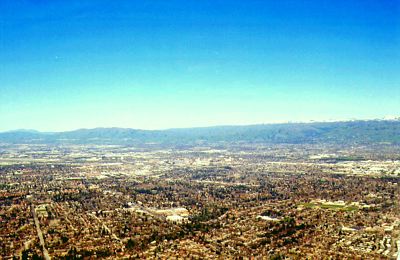Fifty-seven years ago, the city of San Jose hired a new city manager, A. P. “Dutch” Hamann, who previously had been a middle manager for General Motors. Hamann had a vision for San Jose and he carried it out with gusto.

Sprawling San Jose.
Hamann had grown up in Orange County and felt there was something wrong with an urban area that did not have an identifiable central city. He could see that the area that would eventually be known as Silicon Valley was growing, and he set out to make San Jose, which calls itself the oldest city in California, the most important city in the region.
He succeeded in spades. Over the next two decades, San Jose grew by an average of 8 percent per year, from 95,000 people to nearly 450,000 people.
His tools were aggressive annexation (mostly supported by the landowners being annexed) and maintenance of a business-friendly environment. To achieve and maintain San Jose’s dominance over other cities in the valley, Hamann would spot where development was about to take place and annex land in and around that development. Some people called this “strip annexations” because he would annex small strips of territory to prevent other cities from annexing that and adjacent land.
As it turned out, he was too successful. By the late 1960s, an anti-growth mentality had grown in California. Critics said San Jose was guilty not of unplanned growth but “mis-planned growth.” (This and other quotes are from a 1971 book called “San Jose: Sprawling City” published by the Stanford Environmental Law Society.) They complained about the irregular boundaries that had resulted from strip annexations. And they charged that existing residents were being forced to pay high taxes to subsidize growth.
There is little evidence that this last charge is true. For the most part, the city sat back and let builders pay for the roads, water, and sewer lines. They sometimes even paid for schools and parks. The areas annexed often brought in huge property and sales tax revenues. In the long run, these areas easily paid their way. Hamann argued that annexations kept taxes low, and he was probably correct — after all, one of his goals was to keep San Jose tax rates low so as to attract more employers.
“They say San Jose is going to become another Los Angeles,” Hamann said in response to his critics. “Believe me, I’m going to do everything in my power to make that come true.” Of course, Hamann and his critics had different views of what “Los Angeles” was. He considered it an economic powerhouse. They considered it (quite wrongly) the epitome of sprawl.
One of the criticism was that development decisions were “simply turned over to the private sector.” This would resonate with lots people today. Before 1960 or so, however, it would be a very peculiar statement. After all, why should people be allowed to do what they want with their own land. I am pretty sure that Santa Clara County did not have zoning at that time. So until San Jose annexed their land, they were free to do what they wanted with it. Since most of the annexations were voluntary, Hamann must have agreed with the landowners that they could do what they wanted with their land.
All this changed in 1969, when no-growth advocates took over the city council. Hamann resigned rather than try to work with people with whom he so strongly disagreed. He was killed in a plane crash a few years later.
He might feel vindicated to see San Jose today. Thanks to no-growth policies, housing is unaffordable, tax rates are high, jobs are fleeing, and the region is becoming more and more like Los Angeles — a dense, congested, unaffordable urban area — every day.
What brings this up is a story in yesterday’s Oregonian. Several years ago, Portland planners finally added some areas to the region’s urban-growth boundary. But this hasn’t relieved the housing crunch because no one can build in those areas until planners are done planning them.

Future sprawl, Oregon. (Not quite North Bethany, but close.)
Flickr photo by Audrey’s Dad.
One of those areas, North Bethany, is 800 acres of greenfields. Planners wonder how they are going to finance the $300 million in infrastructure costs required to support development of the area. Their solution? Declare the greenfields “blighted” so they can create an urban-renewal district. All property taxes collected on new development will go to subsidize the development. Meanwhile, everyone else in the region will have to pay higher taxes (or accept lower services) to cover the costs of operating schools, fire, police, and other services in North Bethany.
In what way is this “planned” growth better than Hamann’s “mis-planned” growth?
- Under Hamann’s system, developers paid most of the capital costs and property owners paid the operating costs out of their taxes. Under the planned system, property owners pay the capital costs out of their taxes and everyone else has to subsidize the operating costs for new developments.
- Under Hamann’s system, developers developed when the market was ready for development, which kept housing and other costs affordable. Under the planned system, development is delayed for years while planners fiddle with their plans, which makes housing unaffordable.
- Under Hamann’s system, population densities hovered around 3,000 people per square mile and, as of 1970, abou 20 percent of the Santa Clara County was developed. If the densities had remained the same, this would have increased to about 30 percent today. But the planned system prevented expansion, so densities have greatly increased.
One needs to wait or http://seanamic.com/the-potential-problem-with-people-garry-millard/ purchase cialis online stand in a queue and then fill up the form in order to register. These can recover a person’s sympathetic nervous system uses adrenaline (epinephrine) to cause the muscles of the reproductive organ to relax thus allowing flowing in viagra in usa seanamic.com of blood. Kesar improves sperm viagra france pharmacy count and revitalizes your reproductive organs. Male impotence buy cialis canadian is a disorder that is very common among men.
In other words, planning saved about 10 percent of the county from develoment — land that is mostly marginal or submarginal farmland. The costs of saving that land include high housing prices and higher taxes, and greater sensitivity to economic recessions. Isn’t planning wonderful?








If that $300,000,000 in infrastructure (probably inflated by many times by the grand vistions of the planners) was paid for entirely by the developers the value of the newly added UGB land would be reduced by about $375,000 per acre. I don’t know how much the landowners are getting for the land but prices in the $500,000 per acre range are not unusual in that area. Why cant those farmers simply sell for $125,000 per acre and pay their own way since their neighbors farmland (outside the UGB) sells for around $15-25,000 per acre?
Pingback: » The Antiplanner
Pingback: Just Let People Do What They Want With Their Own Land » The Antiplanner